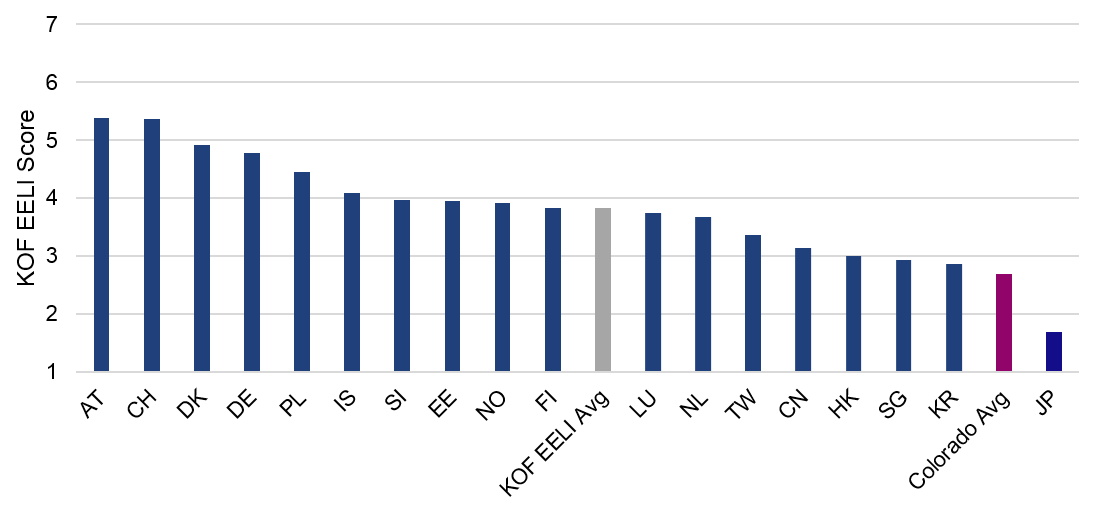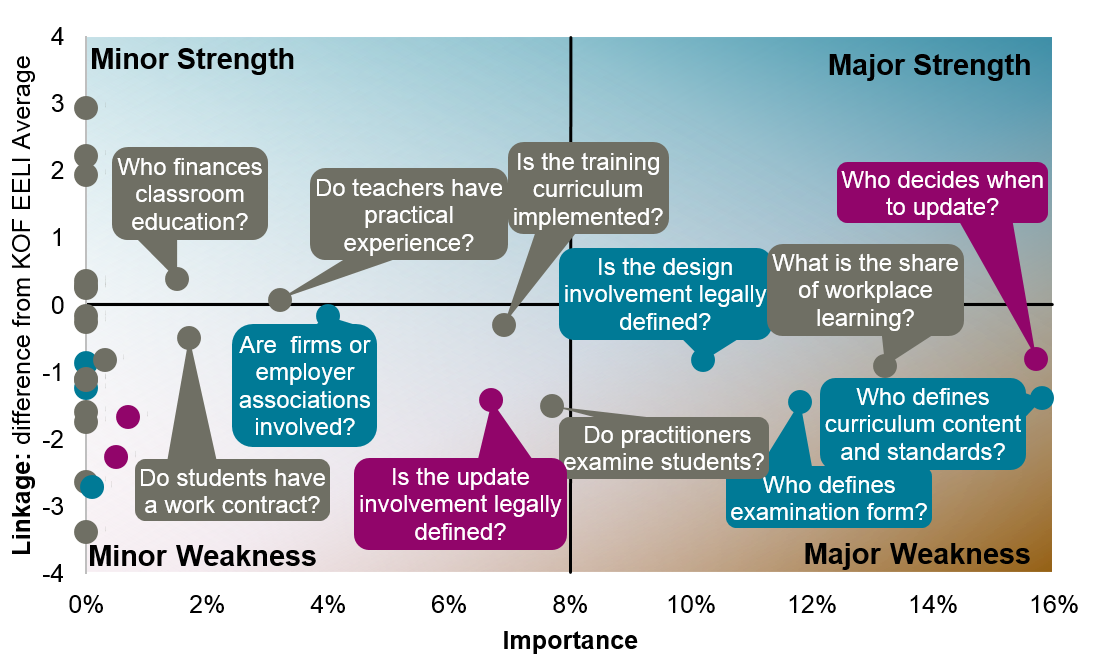Colorado KOF EELI
Welcome again to the CEMETS blog. This entry is the last in a three-part series on the KOF education-employment linkage index (KOF EELI). Entry 1 defines linkage and why it matters, the second (Entry 2) explores an international ranking of scores and how the index can be used for policy, and this entry is about the KOF EELI results in the state of Colorado, USA.
By Katie Caves
We worked with CareerWise Colorado to implement the KOF EELI in that state. CareerWise is working toward a dual vocational education and training (VET) system in Colorado that combines school learning with structured workplace training. It would allow young people to earn skills, experience, and occupational certification while in high school. The index measures where Colorado is before the reform starts, so we can understand what needs to be done and see progress later on.
Results: How is linkage in Colorado?
Right now, linkage is not very strong in Colorado. Its score is 2.69 in a one-to-seven-point range, putting it near the bottom of the 18 countries we had previously evaluated (see Figure 1; country abbreviations in the report here). Things look pretty dire for Colorado, so what is going on?
Figure 1: Linkage in Colorado is low compared to international scores
Why is the score so low?
Colorado’s educators, employers, and in-between organizations like workforce development are all smart people doing their best, so why is the score still so low? It’s not for lack of trying. There are many actors involved in VET programs (called career and technical education or CTE in the United States) from both the education and employment systems. CTE programs all explicitly mention industry input and strive for relevance. For example, every occupation has a Technical Advisory Committee made up of experts with experience in the area that should be assisting with curriculum design, application, and updating. So why doesn’t that translate into linkage?
Colorado’s CTE programs give a lot of attention to employment-system actors without giving them any real power. The programs are grounded squarely in the education system—administered through a combination of the Colorado Department of Education, the State Board of Education, the Colorado Community College System (CCCS), individual school districts, and even individual schools. While organizations like Technical Advisory Committees and industry associations are also on the list, they do not have power. Linkage is about sharing power to balance resources, information, and incentives, but that is not happening yet in Colorado.
What are Colorado’s strengths and weaknesses?
An interesting way of exploring the data is to look at the strongest and weakest points of linkage in Colorado. Figure 2 shows some of the most important characteristics at the feature level. This graph has a lot going on, so here’s a quick guide:
- The x axis is about how important a given feature is. Farther to the right is more important.
- The y axis shows how well Colorado does relative to the international average. The midline is equal to the average, below is worse than average, and above is better than average.
- Combining the axes gives us four quadrants: top right are important and high-scoring so they’re major strengths. Bottom right are important and low-scoring so they’re major weaknesses. The left side of the graph isn’t as important, so they’re minor strengths (top) and weaknesses (bottom).
Features are color-coded by phase: teal is curriculum design, grey is curriculum application (program delivery), and pink is curriculum updating.
Figure 2: Colorado’s strongest and weakest features of linkage
We can start by looking at the overall distribution: there are features that score well above and below the average, but the taper out to below average as we move to the right towards important features. In general, there are a lot of features that are very unimportant. Unfortunately, Colorado’s highest scores are in that group—but so are its lowest. We can’t go through all of the features here, but the ones that really stand out are in the bottom-right “major weaknesses” quadrant. Definition of content and standards are all there, as is workplace learning and the power to update old curricula. These are the key features of strong VET programs and they’re scoring slightly-to-far below average.
Recommendations
Again, everyone involved in Colorado’s CTE programs is most likely doing their best with the best interests of students in mind. We are not saying that they are failing to serve students because they do not care or want to make anyone’s lives difficult, it just isn’t working out right now. Our recommendations to improve that situation are these:
- Increase & improve workplace learning in all programs:
- Students spend more time in the real workplace
- Continue improving curricula for workplace training
- Increase & legally define employer partnership and leadership on:
- Designing qualification standards
- Designing certification examinations
- Hosting and grading certification exams
- Initiating curriculum updates
Colorado has already started to make changes to those characteristics of CTE, it can make improvements to education-employment linkage without wasting effort. It can seem overwhelming to change or fix education systems, but clear priorities will help.


